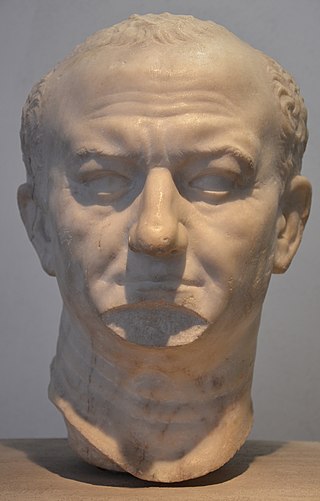
Constantine II was Roman emperor from 337 to 340. The son of the emperor Constantine I, he was proclaimed caesar by his father shortly after his birth. He was associated with military victories over the Sarmatians, Alamanni and Goths during his career, for which he was granted a number of victory titles. He held the consulship four times – in 320, 321, 324, and 329.
The 300s decade ran from January 1, 300, to December 31, 309.
The 310s decade ran from January 1, 310, to December 31, 319.
The 320s decade ran from January 1, 320, to December 31, 329.
The 330s decade ran from January 1, 330, to December 31, 339.
The 340s decade ran from January 1, 340, to December 31, 349.
The 350s decade ran from January 1, 350, to December 31, 359.
Year 339 (CCCXXXIX) was a common year starting on Monday of the Julian calendar. At the time, it was known in Rome as the Year of the Consulship of Constantius and Claudius. The denomination 339 for this year has been used since the early medieval period, when the Anno Domini calendar era became the prevalent method in Europe for naming years.

Year 335 (CCCXXXV) was a common year starting on Wednesday of the Julian calendar. At the time, it was known as the Year of the Consulship of Constantius and Albinus. The denomination 335 for this year has been used since the early medieval period, when the Anno Domini calendar era became the prevalent method in Europe for naming years.

Flavius Claudius Constantius Gallus was a statesman and ruler in the eastern provinces of the Roman Empire from 351 to 354, as Caesar under emperor Constantius II, his cousin. A grandson of emperor Constantius Chlorus and empress Flavia Maximiana Theodora, and a son of Julius Constantius and Galla, he belonged to the Constantinian dynasty. Born during the reign of his uncle Constantine the Great, he was among the few male members of the imperial family to survive the purge that followed Constantine's death. Under Constantius II, Gallus served as deputy emperor, based in Antioch and married to Constantius' sister Constantina. He dealt with a Jewish revolt in the years 351-352. Gallus ultimately fell out of favor with Constantius and was executed, being replaced as Caesar by his younger half-brother Julian.

The gens Flavia was a plebeian family at ancient Rome. Its members are first mentioned during the last three centuries of the Republic. The first of the Flavii to achieve prominence was Marcus Flavius, tribune of the plebs in 327 and 323 BC; however, no Flavius attained the consulship until Gaius Flavius Fimbria in 104 BC. The gens became illustrious during the first century AD, when the family of the Flavii Sabini claimed the imperial dignity.
Flavius Julius Constantius was a member of the Constantinian dynasty, being a son of Emperor Constantius Chlorus and his wife Flavia Maximiana Theodora, a younger half-brother of Emperor Constantine the Great and the father of Emperor Julian.
Flavius Dalmatius, also known as Dalmatius the Censor, was a censor (333), and a member of the Constantinian dynasty, which ruled over the Roman Empire at the beginning of the 4th century.

Flavia Julia Constantia was a Roman empress as the wife of Licinius. She was the daughter of the Roman emperor Constantius Chlorus and his wife Flavia Maximiana Theodora, and younger half-sister of Constantine the Great.

During the reign of the Roman emperor Constantine the Great (306–337 AD), Christianity began to transition to the dominant religion of the Roman Empire. Historians remain uncertain about Constantine's reasons for favoring Christianity, and theologians and historians have often argued about which form of early Christianity he subscribed to. There is no consensus among scholars as to whether he adopted his mother Helena's Christianity in his youth, or, as claimed by Eusebius of Caesarea, encouraged her to convert to the faith he had adopted.

Flavius Hannibalianus was a member of the Constantinian dynasty, which ruled over the Roman Empire in the 4th century.

The Constantinian dynasty is an informal name for the ruling family of the Roman Empire from Constantius Chlorus to the death of Julian in 363. It is named after its most famous member, Constantine the Great, who became the sole ruler of the empire in 324. The dynasty is also called Neo-Flavian because every Constantinian emperor bore the name Flavius, similarly to the rulers of the first Flavian dynasty in the 1st century.
In historiography, the Late or Later Roman Empire, traditionally covering the period from 284 CE to 641 CE, was a time of significant transformation in Roman governance, society, and religion. Diocletian's reforms, including the establishment of the tetrarchy, aimed to address the vastness of the empire and internal instability. The rise of Christianity, legalized by Constantine in 313 CE, profoundly changed the religious landscape, becoming a central force in Roman life. Simultaneously, barbarian invasions, particularly by the Goths and Huns, weakened the Western Roman Empire, which collapsed in 476 CE. In contrast, the Eastern Roman Empire endured, evolving into the Byzantine Empire and laying the foundations for medieval Europe.

Constantine the Great's (272–337) relationship with the four Bishops of Rome during his reign is an important component of the history of the Papacy, and more generally the history of the Catholic Church.
The history of the Later Roman Empire covers the history of the Roman Empire from the beginning of the rule of Diocletian in 284 AD and the establishment of the Tetrarchy in 293 AD by Diocletian to the death of Heraclius in 641 AD.












